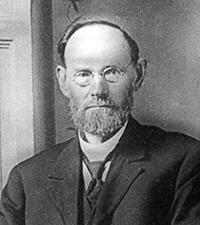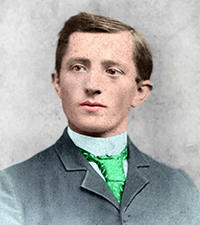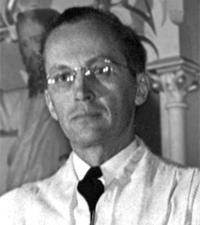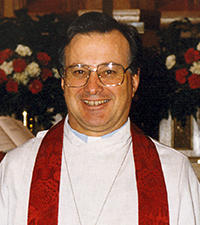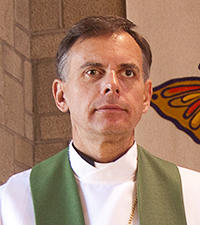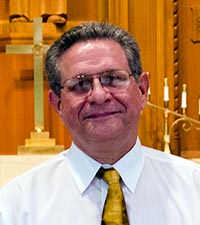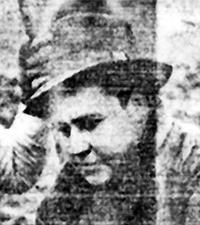Redeemer Pastors:
St. James Pastors:
The History of Redeemer and St. James Lutheran Church
 20th and Grayson St. - Early 1900s In 1884, the congregation that is presently known as Concordia Lutheran Church was growing in the east end of Louisville, on Clay St., near Market. They had, that year, hired a new teacher for their day school, freeing Pastor F. W. Pohlmann to carry on other mission work in the area. Pohlmann, realizing the transportation limitations of the day, saw the need for a second congregation to serve Louisville's developing west end, and began holding Sunday School and Church Services on Sunday evenings at Hope Baptist Church, on the northeast corner of 20th and Grayson (now Cedar) Streets. During the summer months, Pastor Pohlmann would teach a Vacation Bible School, focusing on Martin Luther's Catechism, Bible history, and singing, with the participants accompanied by his violin. Soon, the fledgling group began to look for another location that they could call their own. The spot they chose was to be a 60 ft. by 161 ft. lot, roughly three blocks away, on the southwest corner of 22nd and Madison Streets. There they rented a small frame chapel on the back of the lot from the College Street Presbyterian Church, who had recently disbanded a mission congregation at that location. The rent was reasonable enough, they simply had to "keep the place clean." 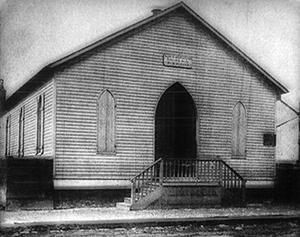 22nd St. - 1890s The congregation that would eventually become Redeemer was slow to grow, and for a time, it was doubtful that it could ever be self-sustaining. In the March 1, 1897 issue of Louisville's German paper, "The Louisville Anzieger," it was recalled that “there was one member who was determined the congregation should survive. He visited all who ever attended and pleaded with them to help him. At the very next service, 20 attended and all dedicated themselves to renewed efforts to increase the membership.” By 1888, the future of the congregation was looking more certain. A vicar, Otto Luebke, was called to lead them under Pastor Pohlmann's guidance. On June 4, one of the members of the east end congregation, Hermann Fruetenicht, purchased the property on the church's behalf for $2,150, and on June 17, they officially organized. The constitution of the Second German Evangelical Lutheran Church, the unaltered constitution of the First German Evangelical Lutheran Church (Concordia), was adopted. The ten original signatories were G. Lambertus, C. Huhn, Hess, C. Simbritzke, A. Hartenstein, W. Menges, H. Wirth, H. Winters, P. Walther, and W. Woertz. The church would join the Missouri Synod on January 10, 1892. When Otto Luebke had to return to the seminary, another vicar, Fredrich Reinking, was called to give interim spiritual guidance. A third vicar, M. Schedler, uncle of our later pastor, Rev. Oscar Schedler, also served the congregation, but the dates of his service are unknown. Just prior to his ordination, a call was issued to candidate Luebke on February 24, 1889, and he was installed sometime that summer. On August 19 of that same year, Pastor Luebke organized and agreed to teach the Christian Day School with 17 pupils. Mr. Huhn was hired to convert a number of church benches to school benches, and to make the blackboard. The school would follow the public school schedule, utilizing the same texts, and run 5 days a week from 8:30 - 2:00. The school grew to 28 students the following year, and the work became too heavy for Pastor Luebke. With financial aid from the synod, the first full time teacher, Theodore Weseloh, was called. He was installed on August 21, 1892 and would serve until 1895. Pastor Luebke took a call to a church in Centerville, Michigan, and preached his farewell sermon on April 1, 1894. To fill the vacancy, Redeemer called Rev. John Schumacher of Hamilton Texas on March 18 of the same year. Pastor Schumacher, a friend of Pastor Luebke, had visited the church just a few years earlier in 1891, while still a student at Concordia Seminary, and had left a lasting impression on the congregation. He was installed on May 20. 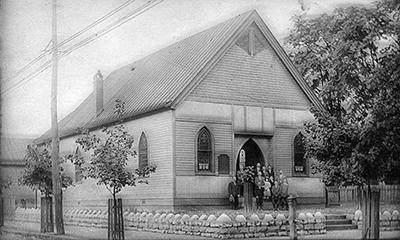 22nd and Madison St. - Early 1900s. Under Rev. Schumacher’s guidance, the young congregation continued to grow, reaching 147 communicant members by 1904. In the summer of 1902, the congregation bought a church building from an Episcopal congregation, The Church of the Ascension, that had stood at the back of the southwest corner lot at 22nd and Jefferson. The building was cut in two, and moved it to their present site, expanding it by 15 feet in the center. The old building was remodeled, and continued to serve as the school. It should be noted that at this time, all services were held in German, a practice which would continue until World War I, although the school was taught in both German and English. In September 1916, one service a month was offered in English. On November 10, 1918, the word "German" was dropped from the church's name, and on November 27, 1921 the name would officially be changed to The Evangelical Lutheran Church of the Redeemer, and English would become the official language. This is still our official name, although we are commonly known and referred to as Redeemer Lutheran Church. 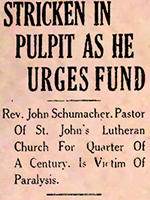 The Louisville Herald, March 24, 1919 On March 23, 1919 Pastor Schumacher delivered, according to some members, his most eloquent and impassioned sermon to date, entitled "Why a Christian Should Give Liberally." The sermon centered around a plan of the Lutheran churches of the world to raise $3,000,000 to care for widows and orphans of deceased pastors and those who had retired from the ministry. As he was drawing to a close, his voice began to falter, his words gradually became unintelligible, and he sank from the pulpit. He was carried to his home next door and died three hours later from what was ruled to be an apoplectic seizure. After his death, the congregation issued a call to his eldest son, Rev. Fred Schumacher, who was serving a congregation in Memphis, Tennessee. He was installed on June 8, 1919, and would soon set an expansion plan into motion that would result in the congregation leaving the 22nd and Madison site. Membership in the church was moving out of the old neighborhood, further to the west, and Redeemer was quickly outgrowing it's facilities on 22nd and Madison. During 1922 and 1923, many meetings were held to decide where and if to move. Then on May 11, 1924 a committee reported that a large tract of land known as the "Dupke Property" (measuring 128 ft. by 400 ft.), on 37th street between River Park Drive and Del Park Terrace, was available. After a visit to the site, it took little time to make the decision. On August 24th the purchase was approved by the Voters' Assembly, the deal was finalized on December 10th, and on May 31, 1925 the new grounds were dedicated on the east porch of the old farmhouse (located on the site of the present church). After a period of fundraising, plans for a new building at the corner of 37th and Del Park were begun promptly by Louisville architect, Arthur G. Tafel, with the cornerstone laid on March 27, 1927. Homes for the pastor and teacher were constructed at the same time. By September 4, the building, with school rooms and a large gymnasium/auditorium, was finished and a dedication service was held. A new Pilcher pipe organ was purchased and dedicated on December 18th for $5,100.  Auditorium at 37th and Del Park - 1938 In the winter of 1937, Louisville suffered from a record flood. At first it was hoped that the rising waters wouldn't reach the church, which was located a safe distance from the Ohio river, but as the rain continued to fall, the inevitable became apparent. Items were hastily moved to the stage and second floor in hopes of preservation, and the neighborhood was soon evacuated with prayers that the damage would be minimal. After several weeks, the flood waters had crested and receded. Returning church members found extensive damage with buckled floors, swollen doors, and a layer of mud and flood debris. After the initial cleanup, the church's basement became a distribution point for relief supplies, and temporary home for services while the auditorium was repaired. A new church building on River Park was a goal from the beginning. Initial plans in 1926 called for construction of a new church to begin January 1, 1932, but fund raising and debt reduction was hampered by the Depression. After the flood, Pastor Schumacher renewed efforts for the new building, and this time plans began to slowly take shape as the congregation was outgrowing its temporary auditorium home. When moving to their new auditorium home in 1927, Redeemer attempted to sell it's old property on 22nd and Madison. A buyer was found, and terms drawn up to pay for the Church, school, and parsonage over a 10 year period. As a result of the Depression and declining membership, the new owners failed to keep up with payments, and the property reverted back to Redeemer. In 1932, as these events were unfolding, Pastor Schumacher approached the Louisville-Lanesville Mission Federation about forming an African-American mission in Redeemer’s old church. The idea was well received but was soon tabled when a Presbyterian congregation rented the property. The new tenants did not have need of the full property, and soon the "Negro Mission," as it was called, was back on, and scheduled to begin in the old school building in the Spring of 1934. Various delays occurred, but by 1939, Rev. Carl F. Spaude (of Pilgrim Lutheran Church) reported that he had contacted several interested families, and work was at last begun to fix up the old school building. The new mission held its first service on August 27th at the home of James Gotier on West Walnut St. with 4 people present, and began holding services in the old school on January 28, 1940. The first four members were confirmed that June, and the name St. James Lutheran Church was adopted by the new congregation. When the old Redeemer site was sold that year, St. James had to find another place to meet, and for a while this would be just a couple of blocks away in a room in the Bourgard School of Music at 2503 W. Walnut St. (now Muhammad Ali Blvd.). Services were conducted in the evenings by Pastor Carl A. Eberhard of Concordia, and were poorly attended. Sometimes not a single person showed up. Appeals were made to the Synod Mission Board, for a full time missionary to properly tackle the work, but none were available. For a time, it looked as though St. James would not survive. Plans for the new church building at Redeemer began to take shape by the end of 1943. An architect, Theo. Steinmeyer, was chosen for the project, and preliminary plans were drawn up. Fundraising was begun, but construction was delayed by World War II. Pastor Fred Schumacher died suddenly of a heart attack on October 22, 1946 after 27 years of service to Redeemer. He would be succeeded by Rev. Oscar A. Schedler who was to continue Pastor Schumacher’s vision of expansion. 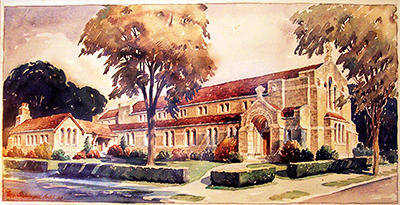 Theo. Steinmeyer's conceptual art for 37th and River Park - 1943 Pastor Schedler was installed on January 26, 1947, and began to study the possibilities of expansion with a new church building. After the war, building prices skyrocketed, and more fundraising was needed. In the meantime, Theo. Steinmeyer's business had picked up considerably, and he was unable to meet Redeemer's construction timetable. Another architect, Edward Hallmann of Chicago, made some cost-saving changes to Steinmeyer's plans, but was unable to work on the project formally due to licensing issues in Kentucky. The Louisville firm of Louis and Henry was at last contracted to make the final changes to the plans and oversee construction. After a long fund raising drive, ground breaking was held on January 21, 1951 at the corner of 37th St. and River Park Drive. The cornerstone was laid on June 3, and a year later, on June 22, 1952, the dedication of our present building took place. The 1950s continued to see expansion of Redeemer’s mission work in the community, and in 1957, a new kitchen and social room were added to the school behind the gym/auditorium. Declining enrollment and rising costs forced Redeemer to finally close its school in 1972, but the building continued to be used for Sunday School, Vacation Bible School, and other church functions. 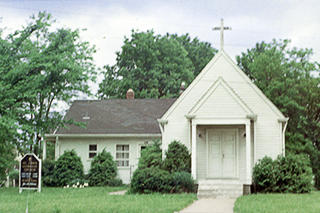 St. James Lutheran Church, 39th and Greenwood - 1960s In 1946, the Louisville Lutheran Federation reached an agreement with the Mission Board of the Central District to absorb 1/3 of a missionary’s salary for St. James (with the Mission Board paying the remaining 2/3), and a search for the congregation’s first full time minister was begun. On March 7, 1948 Rev. George H. Williston was installed in an afternoon service at Concordia. Services for St. James had been suspended for a time, and resumed at the Bourgard School of Music after the installation. The room being rented was not available Sunday mornings, and so Pastor Williston and the Federation determined that services would have to be moved if the congregation was to survive and grow. Temporary quarters were secured at the Swan Funeral Home at 3642 Greenwood Ave., but permanent home was desired, and soon a lot at 39th and Greenwood Ave was purchased for $2,000 with the intention of building a small frame chapel/parsonage. Ground was broken on February 19, 1949, and the $24,980 building was dedicated on May 8th. Pastor Williston resigned from the Ministry very suddenly in March, 1950, and Rev. Robert Haertel was called to replace him. Pastor Haertel was installed at St. James on September 24, 1950. Pastor Haertel soon met the love of his life, Sigrid Kraft, while at a dinner held in Redeemer's auditorium. The two were married on September 14, 1953, and together they would canvas the neighborhood, gradually growing the congregation. As the years went by, the membership grew, and by 1970, a much needed social room was added to the building. The neighborhood around Redeemer and St. James began to change during the late 1960s. As housing became desegregated, the predominantly white neighborhood around Redeemer became predominantly black. Membership was declining, and to strengthen both congregations, it was decided to merge St. James and Redeemer in 1973. The last service was held at St. James Lutheran Church on January 6, 1974. Pastor Schedler announced his retirement in 1976 after 29 years, and a call was placed to Rev. Harold A. Linn, who was installed on September 20, 1976. Redeemer was approached in 1980 by the City of Louisville to buy the old school building to be remodeled and made into a community center. After much prayerful thought and consideration, it was the age of the building coupled with maintenance and utilities that convinced Redeemer to take the city’s offer. 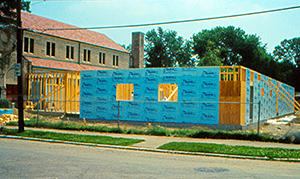 Construction of the Fellowship Hall - 1990 The old parsonage next door to the church was remodeled as a substitute facility for Sunday School classes and small functions, and re-dubbed the Parish House. By 1986, the congregation felt that the lack of adequate space was affecting the ministry, and a building committee was formed to formulate Redeemer’s next phase of growth. The decision to tear down the Parish House was a difficult one, but although it meant temporarily cramped quarters with the Sunday School being moved into the church, it has proved to be the right one. Redeemer’s new Fellowship Hall was dedicated in 1990 with six classrooms, a large kitchen, and a spacious multi-purpose room which has served our needs well ever since. Pastor Linn retired in 1999, and after a year long vacancy, Rev. Thomas Engel accepted our call and was installed on March 4, 2001. Pastor Engel was an important part of the inauguration and expansion of a number of our ministries and served the congregation until his resignation in 2012. 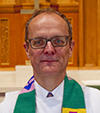 Rev. Eric Moeller (Interim Pastor) 2012-1013 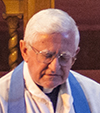 Rev. Henry Loppnow (Vacancy Pastor/ Pastor Emeritus) 2013-2014 During the vacancy, Redeemer called Rev. Eric Moeller, who had been teaching at Campbellsville University, to serve as Interim Pastor which he did until 2013. He was succeeded by Rev. Henry Loppnow who served above and beyond the duties of vacancy pastor in 2013 and 2014. In May, 2014, as Redeemer awaited the installation of its 7th full-time minister, Rev. Steven Ensley, Pastor Loppnow was given the title of "Pastor Emeritus" for the work he has done for the congregation. |
 |
|
|
|
